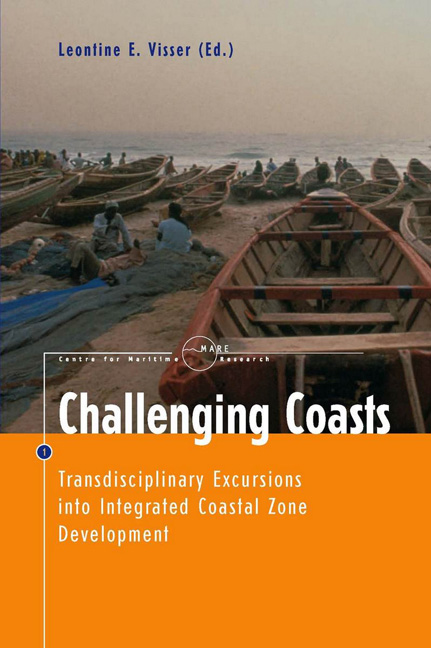Book contents
- Frontmatter
- Series Foreword
- Contents
- Acknowledgments
- 1 Introduction
- 2 Reflections on Transdisciplinarity, Integrated Coastal Development, and Governance
- 3 Biodiversity and the Natural Resource Management of Coral Reefs in Southeast Asia
- 4 A Concerted Approach towards Managing Living Resources in a Marine Protected Area
- 5 ‘Making Do’: Integrating Ecological and Societal Considerations for Marine Conservation in a Situation of Indigenous Resource Tenure
- 6 Basic Principles Underlying Research Projects on the Links between the Ecology and the Uses of Coral Reef Fishes in the Pacific
- 7 The Marine Implementation of the EC Birds and Habitats Directives: the Cases of Shipping and Oil Exploration Compared
- 8 Stakeholder Conflicts and Solutions across Political Scales: the Ibiraquera Lagoon, Brazil
- 9 ‘The Rich Eat Fish and the Poor Eat Pork’: The Decline of the Livelihoods of Handpickers of Aquatic Organisms in North Vietnam
- Index
- List of Contributors
6 - Basic Principles Underlying Research Projects on the Links between the Ecology and the Uses of Coral Reef Fishes in the Pacific
Published online by Cambridge University Press: 28 January 2021
- Frontmatter
- Series Foreword
- Contents
- Acknowledgments
- 1 Introduction
- 2 Reflections on Transdisciplinarity, Integrated Coastal Development, and Governance
- 3 Biodiversity and the Natural Resource Management of Coral Reefs in Southeast Asia
- 4 A Concerted Approach towards Managing Living Resources in a Marine Protected Area
- 5 ‘Making Do’: Integrating Ecological and Societal Considerations for Marine Conservation in a Situation of Indigenous Resource Tenure
- 6 Basic Principles Underlying Research Projects on the Links between the Ecology and the Uses of Coral Reef Fishes in the Pacific
- 7 The Marine Implementation of the EC Birds and Habitats Directives: the Cases of Shipping and Oil Exploration Compared
- 8 Stakeholder Conflicts and Solutions across Political Scales: the Ibiraquera Lagoon, Brazil
- 9 ‘The Rich Eat Fish and the Poor Eat Pork’: The Decline of the Livelihoods of Handpickers of Aquatic Organisms in North Vietnam
- Index
- List of Contributors
Summary
Introduction
Pacific island countries cover a very wide geographical area, spanning more than 10,000 kilometres from west to east. This region is the most diverse in the world for shallow water marine life, a characteristic due in large part to the presence of its extensive coral reefs. There are well over five thousand fish species known to date in this area, of which several hundred have not yet been described. This diversity is reflected in the number of coastal organisms of human interest in this area, as well as by the variety of the uses of lagoon and reef fishes or invertebrates (Dalzell et al. 1996). In most Pacific island countries, the catch coming from coastal resources is used mainly for subsistence. This contrasts with offshore fisheries, in particular those for tuna, which are essentially market driven (Gillett and Lightfoot 2001). Because of the low monetary exchange that these coastal resources generate, little attention has so far been given to their management.
Most Pacific island states are facing dramatic increases in their populations. This is resulting in many anthropogenic effects on coastal ecosystems and deep modifications of the socio-economic conditions of human populations, such as a crowding of the metropolitan islands, a decrease in the population of the islands most distant from the major cities, and profound changes in social structure. At the same time, the influence of the market economy is increasing, due in particular to demand for fish products from urban areas and the export of fisheries products to the Asian market or to emerging markets (Dalzell et al. 1996; Sadovy and Vincent 2002). The impact of the market economy is also felt by the introduction and use of increasingly efficient, and at times destructive, gears (Dalzell et al. 1996) and by the decrease in some places of subsistence fishing. On the other hand, subsistence fishing, as previously mentioned, remains a major source of food for large groups within these populations (Gillett and Lightfoot 2001). Subsistence uses are usually in conflict with monetary uses of coastal resources. As coastal resources are a major source of protein for Pacific island populations, these new monetary uses of resources not only result in increased ecological stress, but threaten food security and change feeding habits. In the coming years, drastic changes in resource levels and their uses are probable and in great part dependent on the population level.
- Type
- Chapter
- Information
- Challenging CoastsTransdisciplinary Excursions into Integrated Coastal Zone Development, pp. 119 - 158Publisher: Amsterdam University PressPrint publication year: 2004
- 6
- Cited by



